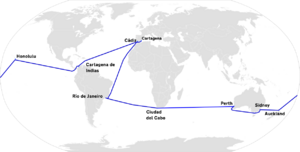Malaspina Expedition 2010 facts for kids
The Malaspina expedition was a big science trip around the world. It aimed to study how global change affects our oceans. It also explored the amazing variety of life, called biodiversity, found in the sea.
About 250 scientists took part in this eight-month journey. They sailed on two special research ships, the Hespérides and the Sarmiento de Gamboa. The expedition started in December 2010. Besides doing important research, it also helped train young scientists. The goal was to improve our understanding of the ocean and share this knowledge with everyone.
The Spanish Ministry of Science and Innovation supported this project. The Spanish National Research Council (CSIC) led it, with help from the Spanish Navy. The expedition was named after an earlier scientific journey. That first Malaspina Expedition happened between 1789 and 1794. It was led by Alejandro Malaspina. After his return, Malaspina faced difficulties, and much of his expedition's findings were kept secret for a long time. They were not fully published until the late 20th century.
Contents
What the Expedition Wanted to Do
Studying How Global Change Affects Oceans
Global change means how human actions impact our planet. Even small actions in one place can affect the whole Earth. The ocean is very important for controlling Earth's climate. It absorbs a lot of carbon dioxide (CO2) and other things made by humans.
The Malaspina project collected many samples and data about the environment and sea life. This collection, called Colección Malaspina 2010, is now available for other scientists. It will help them study how global changes might affect the oceans in the future. For example, new tools might help find tiny amounts of pollution that we cannot see today.
Discovering Life in the Deep Ocean
More than half of Earth's surface is covered by oceans deeper than 3,000 meters. This makes the deep ocean the biggest ecosystem on our planet. For a long time, we knew very little about these deep areas. It's often said we know more about the Moon or Mars than about Earth's own deep oceans!
Now, new technologies let scientists explore life in these dark, deep parts of the ocean. They can find out what kinds of creatures live there. They can also learn about the special ways these creatures survive. Exploring deep-sea biodiversity could lead to important new discoveries. These discoveries might even help us in biotechnology, like finding new medicines.
Looking Back at the First Malaspina Expedition
The project also looked at the original Malaspina expedition from history. Scientists studied old records from the countries Malaspina visited. They wanted to understand how that first journey affected those places. They also reviewed the life and work of Alejandro Malaspina himself. They focused on what happened after his expedition.
Helping Marine Science in Spain and Public Understanding
Spain has a long history of exploring the world's resources. It is still a leader in ocean research today. This project aimed to help marine scientists in Spain work together even more. It also wanted to teach the public about science and global change. They did this through events like exhibitions and talks.
Inspiring Young People and Training New Scientists
The Malaspina expedition was a great chance to train young researchers in marine science. Four university programs worked together to create a special training course. This course was part of the Malaspina Expedition Doctoral Programme. It was funded by the BBVA Foundation and the CSIC. A highlight of this training was using the Sarmiento de Gamboa ship as a "floating university." Students learned about oceanography while sailing from Miami to Las Palmas.
How the Expedition Was Organized
The expedition's research was divided into different parts. These parts helped organize the many scientific studies.
Main Research Areas
- Ocean Physics: Studying how the ocean's physical properties are changing.
- Ocean Chemistry: Looking at carbon, nutrients, and gases in the ocean.
- Air Pollution: Studying how pollution from the air lands in the ocean.
- Ocean Life and Light: Researching how light affects tiny ocean plants (phytoplankton).
- Tiny Ocean Life: Exploring the many kinds of microbes and their roles in the ocean.
- Zooplankton: Studying small ocean animals and their importance.
- History of Malaspina: Researching the science and politics of the original Malaspina expedition.
Supporting Areas
- Coordination: Making sure everything worked together smoothly.
- Science and Society: Connecting science with the public.
- Training: Educating new scientists.
- Integration: Bringing all the different research parts together.
The Expedition's Journey
The Malaspina expedition sailed from December 2010 to July 2011. Two research ships were involved. The Hespérides, run by the Spanish Navy, sailed all the way around the world. The R/V Sarmiento de Gamboa, run by the Marine Technology Unit from the CSIC, sailed from Cadiz to Santo Domingo (Dominican Republic) and back to Cadiz. In Cadiz, it hosted the "floating university" for students.
The Hespérides' Route
- Cartagena - Cadiz
- Cadiz - Río de Janeiro
- Rio de Janeiro - Cape Town
- Cape Town - Perth
- Perth - Sydney
- Sydney - Auckland
- Auckland - Honolulu
- Honolulu - Cartagena de Indias
- Cartagena de Indias - Cádiz
See also
 In Spanish: Expedición Malaspina (2010-2011) para niños
In Spanish: Expedición Malaspina (2010-2011) para niños


